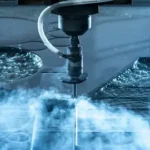Waterjet cutting is a highly advanced manufacturing process that utilizes high-pressure water streams to cut through various materials with precision and efficiency. This cutting-edge technology is widely employed in industries such as aerospace, automotive, and construction due to its versatility and ability to handle a diverse range of materials, including metals, composites, glass, and ceramics. Unlike traditional cutting methods that rely on heat or mechanical force, waterjet cutting offers a non-contact, cold-cutting technique that minimizes material distortion and enhances overall production efficiency.
One of the key advantages of waterjet cutting is its ability to produce highly accurate and clean cuts without the need for secondary finishing processes. This not only reduces production time but also lowers operational costs, making it a preferred choice for manufacturers looking to optimize efficiency. As industries strive to enhance productivity and sustainability, adopting waterjet cutting solutions has become an essential strategy for achieving high-quality output with minimal waste.
Key Advantages of Waterjet Cutting in Manufacturing
Waterjet cutting provides a range of benefits that contribute to increased production efficiency. One of the most notable advantages is its ability to cut without generating heat, which eliminates the risk of heat-affected zones (HAZ) in the material. This is particularly important for industries that work with heat-sensitive materials, as it prevents structural damage and preserves material integrity. Additionally, the process is highly precise, allowing for intricate cuts with tolerances as tight as ±0.001 inches, ensuring that manufacturers achieve accurate and consistent results.
Another significant benefit of waterjet cutting is its ability to reduce material waste. Traditional cutting methods often result in excess scrap due to kerf width and imprecise cutting. However, waterjet cutting uses a fine, high-pressure stream that minimizes kerf width and maximizes material utilization. This leads to cost savings, as manufacturers can optimize raw material usage while maintaining high-quality production output. Furthermore, the ability to stack materials and cut multiple layers simultaneously further enhances efficiency and throughput.
Enhancing Production Speed and Versatility with Waterjet Cutting
Waterjet cutting is renowned for its ability to accelerate production timelines while maintaining exceptional quality. Unlike conventional cutting techniques that require tool changes and frequent maintenance, waterjet cutting systems offer a streamlined process that reduces downtime. Since the technology does not involve mechanical components that wear out quickly, maintenance requirements are significantly lower, leading to increased uptime and uninterrupted production cycles. This translates to faster turnaround times and improved efficiency in high-demand manufacturing environments.
Versatility is another key aspect that makes waterjet cutting an invaluable solution for production facilities. Whether cutting through metals, rubber, plastics, or stone, waterjet systems can handle an extensive range of materials with ease. This adaptability makes it an ideal choice for manufacturers working with diverse material compositions, allowing them to complete various projects without needing to invest in multiple cutting technologies. As a result, businesses can enhance their flexibility, streamline operations, and cater to a broader market demand.
Cost Efficiency and Environmental Benefits of Waterjet Cutting
In addition to enhancing production efficiency, waterjet cutting also offers substantial cost savings. The precision of the process ensures minimal material wastage, reducing the need for additional raw materials. Furthermore, since waterjet cutting does not rely on consumable cutting tools such as saw blades or laser tubes, operational costs associated with tool replacement and maintenance are significantly lower. These factors contribute to a more cost-effective manufacturing process, allowing businesses to allocate resources to other critical aspects of production.
Waterjet cutting is also an environmentally friendly alternative to traditional cutting methods. The process does not produce hazardous fumes, toxic gases, or heat-affected waste, making it a safer option for workers and the surrounding environment. Additionally, waterjet cutting uses water as its primary medium, which can be recycled and reused, further reducing its ecological footprint. By integrating waterjet cutting into their operations, manufacturers can improve their sustainability efforts while maintaining high production efficiency.
Future Prospects and Innovations in Waterjet Cutting Technology
As technology continues to evolve, advancements in waterjet cutting are further enhancing production efficiency. Modern waterjet systems are now equipped with computer numerical control (CNC) capabilities, enabling automated cutting with unparalleled precision. The integration of artificial intelligence (AI) and machine learning further optimizes cutting paths, reduces errors, and improves overall efficiency. These innovations are paving the way for even more streamlined manufacturing processes, allowing industries to meet growing market demands with increased speed and accuracy.
Moreover, the development of hybrid waterjet cutting systems is expanding the possibilities of this technology. Combining waterjet cutting with other techniques, such as laser or plasma cutting, allows manufacturers to leverage the strengths of multiple processes for superior results. These hybrid systems provide greater flexibility, improved cost efficiency, and enhanced material processing capabilities. As industries continue to seek innovative solutions to improve production efficiency, waterjet cutting remains a cornerstone technology that will drive future manufacturing advancements.
Conclusion
Waterjet cutting has revolutionized modern manufacturing by providing a highly precise, versatile, and cost-efficient cutting solution. Its ability to handle a wide range of materials, reduce waste, and accelerate production timelines makes it an invaluable tool for industries striving to optimize efficiency. With ongoing technological advancements and increasing emphasis on sustainability, waterjet cutting will continue to play a vital role in shaping the future of manufacturing. By adopting this cutting-edge technology, businesses can achieve higher productivity, minimize operational costs, and stay competitive in an ever-evolving industrial landscape.

